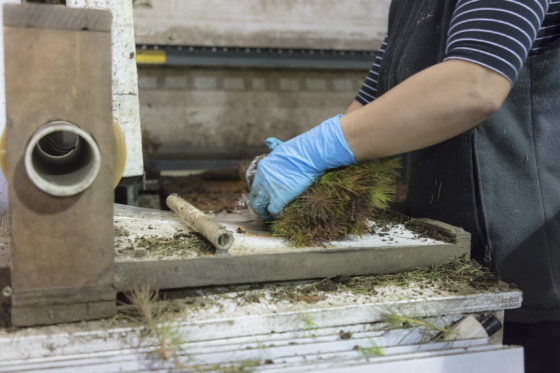Forest nursery workers who grow trees for planting need proper training, lighting, and posture to avoid musculoskeletal injuries (MSIs).

Photo credit: © WorkSafeBC (Workers’ Compensation
Board of B.C.), used with permission
I came across this CBC news story that said planting a trillion trees could be the “most effective way to fight global warming.” It also included this interesting statistic: professional tree planters can plant up to 2,000 trees a day by hand. And with the help of machinery, they can plant up to 7,000 trees!
Recently, I learned more about where these trees come from. It all starts with forest nursery workers who plant, grow, and package tiny seedlings. Their work involves a lot of repeated movements, forceful exertions, and other factors that put them at risk of developing musculoskeletal injuries (MSIs).
Elizabeth Engelbertink is the manager of PRT forest nursery in Coldstream, B.C. She described for me the changes she and her team have made to reduce MSI risks for workers. For example, they installed task-specific lighting at all the tables to replace the big halide lights at the top of the shop. This ensured everyone had good lighting and there weren’t any shadows.
“Whenever there are shadows, people try to avoid them by positioning their bodies so they are working in the light,” Elizabeth says. “You also end up leaning closer to your table when you don’t have good lighting.”
They also adjusted the angle of the conveyor belt that moves the many seedlings. This helps workers to avoid neck strain caused by looking down for long periods. Plus, they have workers rotate jobs every half-hour.
Gradual start is key to preventing MSIs
The bulk of the work takes place during an eight-week harvest in the fall. During this time, the company hires a number of seasonal workers. There is also a smaller harvest in the summer, along with seed planting and maintenance at other times.
Elizabeth says the first three days of the harvest are devoted to worker training. In addition to this gradual start, workers also take an extra “break day” during the first week.
“The training is all about technique, quality, and letting workers’ muscles build up,” says Elizabeth: “The extra break day gives them a chance to rest in the middle of their first week to let their bodies heal and condition.”
The ultimate goal is a zero-injury workplace, says Elizabeth, because they understand that safety and production really go together.
“With everything safe and working smoothly, your production numbers are better,” she says. “If your people feel safe and they’re working effectively, your money is there — so safety really does pay for itself.”
For more information on preventing MSIs in forest nurseries, see these WorkSafeBC information sheets.


